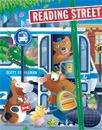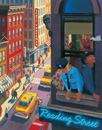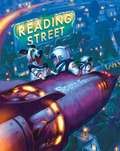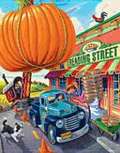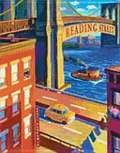- Table View
- List View
Reading Street (Indiana)
by Candy Dawson Boyd Sharon Vaughn Camille Blachowicz Wendy Cheyney Connie Juel Edward Kame'Enui Donald Leu Jeanne Paratore Sam Sebesta Deborah Simmons Susan Watts-Taffe Karen Kring Wixson Peter Afflerbach P. David PearsonNIMAC-sourced textbook
Reading Street (Texas Edition)
by Editors at Pearson EducationLearn more about good reading comprehension skills with this collection of interesting stories and non-fiction.
Reading Street (Texas Edition, Third Grade)
by Editors at Pearson EducationBuild your reading and writing skills with these fun stories and assignments!
Reading Street (West Virginia)
by Candy Dawson Boyd Sharon Vaughn Camille Blachowicz Wendy Cheyney Connie Juel Edward Kame'Enui Donald Leu Jeanne Paratore Sam Sebesta Deborah Simmons Susan Watts-Taffe Karen Kring Wixson Peter Afflerbach P. David PearsonNIMAC-sourced textbook
Reading Street -- Unit 4 (Indiana)
by Pearson Scott ForesmanLiterature Anthology Textbook for First Grade
Reading Street 1.1(Indiana)
by Candy Dawson Boyd Camille Blachowicz Wendy Cheyney Connie Juel Edward Kame'Enui Donald Leu Jeanne Paratore Sam Sebesta Deborah Simmons Karen Kring Wixson Peter Afflerbach P. David Pearson Sharon Vaughn Susan Watts-TaffeDear Indiana Reader, A new school year is beginning. Are you ready? You are about to take a trip along a famous street--Scott Foresman Reading Street. On this trip you will meet exciting characters, such as a pig in a wig, a blue ox, and a dinosaur. As you read the stories and articles, you will gain exciting new information that will help you in science and social studies. While you're enjoying these exciting pieces of literature, you will find that something else is going on--you are becoming a better reader, gaining new skills and polishing old ones. Have a great trip, and send us a postcard! Sincerely, The Authors
Reading Street Grade 1 Unit 1
by Candy Dawson Boyd Camille Blachowicz Peter AfflerbachNIMAC-sourced textbook
Reading Street Grade 1 Unit 3
by Scott ForesmanScientifically research-based program supports state standards in literacy, science, mathematics, social studies, art and music to prepare children for Kindergarten. Teacher's Guides help build and assess children's cognitive skills, alphabet knowledge, and social-emotional development. Interactive charts with songs and activities inspire class discussion and build oral vocabulary. Big Books, Trade Books, and Little Books provide shared reading experiences and develop children's concepts of print.
Reading Street Grade 3.1
by Scott ForesmanScientifically research-based program supports state standards in literacy, science, mathematics, social studies, art and music to prepare children for Kindergarten. Teacher's Guides help build and assess children's cognitive skills, alphabet knowledge, and social-emotional development. Interactive charts with songs and activities inspire class discussion and build oral vocabulary. Big Books, Trade Books, and Little Books provide shared reading experiences and develop children's concepts of print.
Reading Street Grade 3.2
by Candy Dawson Boyd Sharon Vaughn Camille Blachowicz Wendy Cheyney Connie Juel Edward Kame'Enui Donald Leu Jeanne Paratore Sam Sebesta Deborah Simmons Susan Watts-Taffe Karen Kring Wixson Peter Afflerbach P. David PearsonNIMAC-sourced textbook
Reading Street Indiana (Unit #3)
by Pearson Scott ForesmanReading/Language Arts Textbook for First Grade
Reading Street Indiana, Unit 5
by Candy Dawson Boyd Camille Blachowicz Wendy Cheyney Connie Juel Edward Kame'Enui Donald Leu Jeanne Paratore Sam Sebesta Deborah Simmons Karen Kring Wixson Peter Afflerbach P. David Pearson Sharon Vaughn Susan Watts-TaffeScott Foresman Reading Street has many corners and crossroads. At each corner you will learn about something new and interesting. You will read about great ideas in science and social studies. You will have fun reading about clever chicks and smart mice detectives! You may want to hurry down the street and read these wonderful stories and articles! But slow down, take your time, and enjoy yourself! You never know whom you might meet on Reading Street!
Reading Street Indiana: Unit 2
by Pearson Scott ForesmanEnglish Language Arts textbook for First Grade
Reading Street Texas
by Candy Dawson Boyd Sharon Vaughn Camille Blachowicz Connie Juel Edward Kame'Enui Donald Leu Jeanne Paratore Sam Sebesta Deborah Simmons Karen Kring Wixson Peter Afflerbach Elena Izquierdo Alfred Tatum Susan Watts TaffeAs the readers read these stories and articles, they will learn new things that will help you in science and social studies.
Reading Street Unit 1
by Candy Dawson Boyd Sharon Vaughn Camille Blachowicz Wendy Cheyney Connie Juel Edward Kame'Enui Donald Leu Jeanne Paratore Sam Sebesta Deborah Simmons Susan Watts-Taffe Karen Kring Wixson Peter Afflerbach P. David PearsonNIMAC-sourced textbook
Reading Street [California, Unit 1]
by Candy Dawson Boyd Sharon Vaughn Camille Blachowicz Wendy Cheyney Connie Juel Donald Leu Jeanne Paratore Sam Sebesta Deborah Simmons Karen Kring Wixson Peter Afflerbach Alfred Tatum Susan Watts Taffe Edward Kame' EnuiReading Street California is talked about students understand the basic features of reading, writing, written and oral English language conventions, listening and speaking. Besides that, the students understand the basic features of reading. They select letter patterns and know how to translate them into spoken language by using phonics, syllabication, and word parts. They apply this knowledge to achieve fluent oral and silent reading.
Reading Street [California, Unit 2]
by Candy Dawson Boyd Sharon Vaughn Camille Blachowicz Wendy Cheyney Connie Juel Donald Leu Jeanne Paratore Sam Sebesta Deborah Simmons Karen Kring Wixson Peter Afflerbach Alfred Tatum Susan Watts Taffe Edward Kame' EnuiReading Street California is talked about students understand the basic features of reading, writing, written and oral English language conventions, listening and speaking. Besides that, the students understand the basic features of reading. They select letter patterns and know how to translate them into spoken language by using phonics, syllabication, and word parts. They apply this knowledge to achieve fluent oral and silent reading.

